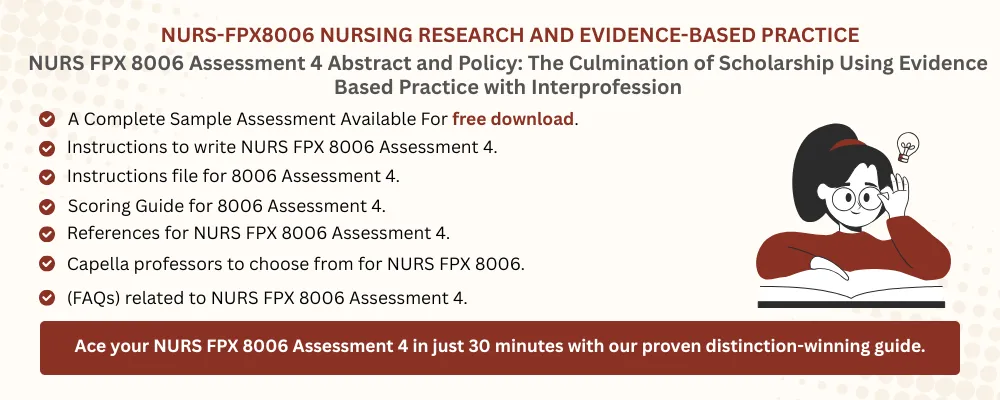NURS FPX 8006 Assessment 4 Sample FREE DOWNLOAD
NURS FPX 8006 Assessment 4 Abstract and Policy: The Culmination of Scholarship Using
Evidence-Based Practice with Interprofessional Team
Student Name
Capella University
NURS-FPX8006
Professor Name
Submission Date
Abstract: The Culmination of Scholarship Using Evidence-Based Practice with an Interprofessional Team
The creation of interprofessional team partnerships has to be built on systems thinking, shared decision-making, and collaborative communication to enhance care delivery. Collaboration among nurses, pharmacists, physical therapists, and geriatricians is a positive experience and leads to a holistic approach toward fall prevention (Will et al., 2020). The collaborations are based on respect, defined roles, and constant feedback. The implementation of the general systems theory (GST) allows healthcare organizations to consider the problem of fall prevention as a system problem, not an individual nursing assignment, and understand that all components of care are interdependent (Jason & Bobak, 2022). The value of collaborative interventions is repeated in the literature in the three assessments. In their article, Turner et al. (2022) emphasized that interventions with nurse-led and team-supported programs decreased the fall rates in older patients significantly. The project conducted by Lallemand et al. (2025) resulted in a 51 percent decrease in the number of falls via organized team involvement. Chidume (2021) demonstrated that fall prevention education and follow-up in community clinics lowered fall risk scores.
In contrast, Dykes et al. (2023) pointed out that the estimated cost savings as a result of fall-related injury were between 13,000 and 30,000 dollars per injury. The articles highlight the economic and clinical benefits of interprofessional strategies. Teams are advised to conduct interdisciplinary meetings, combine electronic health records (EHRs) and predictive tools, and embrace diversity, equity, and inclusion (DEI) principles to diversify the way they approach a problem (Bendowska & Baum, 2023; Calduch et al., 2021). The concept of social constructivism promotes the fact that information can be co-created via a group discussion and trust (Sangani & Toh, 2023). Using the scholarship of nursing by conducting ethical evidence-based practices, professionals can drive the change in care delivery. Innovation and sustainability are motivated by effective communication, collaboration, and considering the nature of the systems. The interprofessional collaboration provides knowledge-based and value-based outcomes that guarantee quality and cost-effective care in the continuum (Ojo & Thiamwong, 2022). Systems thinking makes fall prevention programs coordinated, information-based, and effective in the short and long-term care outcomes.
Policy: The Culmination of Scholarship Using Evidence-Based Practice with Interprofessional Team
Policy Title: Interprofessional Evidence-Based Fall Prevention for Hospitalized Elderly Patients
Policy Statement
The policy describes a complex, interdisciplinary, evidence-based strategy to prevent falls in elderly patients in the hospital. The policy focuses on interprofessional cooperation between nurses, physical therapists, pharmacists, and geriatricians to provide patient-centered care, high-quality, cost-effective services (Will et al., 2020). Based on the general systems theory and informed by recent academic studies, the policy gives healthcare professionals practical recommendations on how to implement fall prevention interventions throughout the continuum of care (Jason & Bobak, 2022). The policy will make elderly patients safer, more efficient, and provide more equitable care through integrating evidence-based practices, systems thinking, and collaborative decision-making.
Supporting Scholarly Literature
Falls can be described as one of the most widespread preventable adverse events in hospitals, particularly in older adults (Sangani & Toh, 2023). There is evidence that the interdisciplinary team approach can be very effective in reducing the rate of falls, enhancing patient outcomes, and decreasing the costs of healthcare. As an example, a 51 percent reduction in falls was recorded after a structured, nurse-led team intervention (Turner et al., 2022). Chidume (2021) concluded that community-based education and follow-up had a major impact on decreasing the fall risk scores.
Dykes et al. (2023) pointed out that fall prevention saves between 13,000 and 30,000 dollars per fall, which makes fall prevention a clinical and financial priority. Bendowska & Baum (2023) pointed out that interdisciplinary communication and diversity, equity, and inclusion (DEI) principles are essential in fostering innovation. In contrast, Saleem et al. (2021) reaffirmed that knowledge creation in teams contributes to shared learning based on social constructivism. As evidenced by Jason and Bobak (2022), general systems theory can be used to coordinate the efforts of interdependent processes and professional contributions to achieve common goals. The results indicate that the structured team approaches generate measurable health system improvements in the improvement of patient safety and operational effectiveness.
Guidelines for Evidence-Based Interprofessional Practice
- Compose interprofessional fall prevention teams comprising nurses, physical therapists, pharmacists, and geriatricians.
- Undertake standardized fall risk assessment on admission and during transitions of care.
- Implement evidence-based procedures that will result in team-based fall prevention strategies (Ojo & Thiamwong, 2022).
- Monitor the risks in real-time by using electronic health records (EHRs) and predictive analytics (Calduch et al., 2021).
- Conduct frequent interdisciplinary meetings to review the cases and revise the care plans (Bendowska & Baum, 2023).
- Make sure that pharmacists review medications to reduce sedative or fall medications (Sholabi et al., 2020).
- Interventions and role interdependence can be matched using the general systems theory (Jason & Bobak, 2022).
- Encourage DEI in team membership and decision-making, and be open to contributions from all roles and cultural perspectives.
- Assess results and modify interventions continuously, taking into consideration the real-time results and patient responses (Calduch et al., 2021).
The quality and safety committee will review the policy every year with the interprofessional practice board. The adjustments will be done to the outcome data, clinical innovations, and new research evidence (Calduch et al., 2021). The team members are also supposed to give feedback and propose improvements every year. The trend of fall incidents and the measure of patient safety will be examined every three months. Any revision will be recorded and reported to all the departments so that there can be uniform implementation.
Related Free Assessments for NURS-FPX8006
Instructions To Write NURS FPX 8006 Assessment 4
If you need guidance to write NURS FPX 8006 Assessment 4 Abstract and Policy: The Culmination of Scholarship Using Evidence Based Practice with Interprofession, contact Tutors Academy. Our expert tutors are ready to assist you.
Instruction file for 8006 Assessment 4
Contact us to get the instruction file for this assessment.
Scoring Guide for 8006 Assessment 4
Contact us to get the Scoring file for this assessment.
References For NURS FPX 8006 Assessment 4
References for Abstract
Bendowska, A., & Baum, E. (2023). The significance of cooperation in interdisciplinary health care teams as perceived by Polish medical students. International Journal of Environmental Research and Public Health, 20(2), 1–14. https://doi.org/10.3390/ijerph20020954
Calduch, E., Muscat, N., Krishnamurthy, R. S., & Ortiz, D. (2021). Technological progress in electronic health record system optimization: Systematic review of systematic literature reviews. International Journal of Medical Informatics, 152(1), 3–7. https://doi.org/10.1016/j.ijmedinf.2021.104507
Chidume, T. (2021). Promoting older adult fall prevention education and awareness in a hospital setting: A nurse-led intervention. Applied Nursing Research, 57(57), 11–17. https://doi.org/10.1016/j.apnr.2020.151392
Dykes, P. C., Lipsitz, S., Franz, C., Adelman, J., Adkison, L., Bogaisky, M., Carroll, D., Carter, E., Herlihy, L., Lindros, M. E., Ryan, V., Scanlan, M., Walsh, M.-A., Wien, M., & Bates, D. W. (2023). Cost of inpatient falls and cost-benefit analysis of implementation of an evidence-based fall prevention program. Health Forum, 4(1), 3–7. https://doi.org/10.1001/jamahealthforum.2022.5125
Jason, L. A., & Bobak, T. (2022). Using systems theory to improve intervention outcomes. Professional Psychology: Research and Practice, 53(4), 415–422. https://doi.org/10.1037/pro0000467
Lallemand, W., Coughlin, V., Tammaro, G., Pierluissi, H., & Williams, W. (2025). Nursing-Led targeted strategies for preventing falls in older adults. Geriatric Nursing, 62(2), 297–299. https://doi.org/10.1016/j.gerinurse.2025.01.050
Ojo, E. O., & Thiamwong, L. (2022). Effects of nurse-led fall prevention programs for older adults: A systematic review. Pacific Rim International Journal of Nursing Research, 26(3), 8–12. https://pmc.ncbi.nlm.nih.gov/articles/PMC9432804/
Sangani, C., & Toh, E. (2023). Inpatient falls and orthopaedic injuries in elderly patients: A retrospective cohort analysis from a falls register. Cureus, 15(10), 8–12. https://doi.org/10.7759/cureus.46976
Turner, K., Staggs, V. S., Potter, C., Cramer, E., Shorr, R. I., & Mion, L. C. (2022). Fall prevention practices and implementation strategies. Journal of Patient Safety, 18(1), 5–7. https://doi.org/10.1097/pts.0000000000000758
Will, K. K., Johnson, M. L., & Lamb, G. (2020). Team-based care and patient satisfaction in the hospital setting: A systematic review. Journal of Patient-Centered Research and Reviews, 6(2), 158–171. https://doi.org/10.17294/2330-0698.1695
References for Policy
Bendowska, A., & Baum, E. (2023). The significance of cooperation in interdisciplinary health care teams as perceived by Polish medical students. International Journal of Environmental Research and Public Health, 20(2), 1–14. https://doi.org/10.3390/ijerph20020954
Calduch, E., Muscat, N., Krishnamurthy, R. S., & Ortiz, D. (2021). Technological progress in electronic health record system optimization: Systematic review of systematic literature reviews. International Journal of Medical Informatics, 152(1), 3–7. https://doi.org/10.1016/j.ijmedinf.2021.104507
Chidume, T. (2021). Promoting older adult fall prevention education and awareness in a hospital setting: A nurse-led intervention. Applied Nursing Research, 57(57), 11–17. https://doi.org/10.1016/j.apnr.2020.151392
Dykes, P. C., Lipsitz, S., Franz, C., Adelman, J., Adkison, L., Bogaisky, M., Carroll, D., Carter, E., Herlihy, L., Lindros, M. E., Ryan, V., Scanlan, M., Walsh, M.-A., Wien, M., & Bates, D. W. (2023). Cost of inpatient falls and cost-benefit analysis of implementation of an evidence-based fall prevention program. Health Forum, 4(1), 3–7. https://doi.org/10.1001/jamahealthforum.2022.5125
Jason, L. A., & Bobak, T. (2022). Using systems theory to improve intervention outcomes. Professional Psychology: Research and Practice, 53(4), 415–422. https://doi.org/10.1037/pro0000467
Ojo, E. O., & Thiamwong, L. (2022). Effects of nurse-led fall prevention programs for older adults: A systematic review. Pacific Rim International Journal of Nursing Research, 26(3), 8–12. https://pmc.ncbi.nlm.nih.gov/articles/PMC9432804/
Saleem, A., Kausar, H., & Deeba, F. (2021). Social constructivism: A new paradigm in teaching and learning environments. Perennial Journal of History, 2(2), 403–421. https://doi.org/10.52700/pjh.v2i2.86
Sangani, C., & Toh, E. (2023). Inpatient falls and orthopaedic injuries in elderly patients: A retrospective cohort analysis from a falls register. Cureus, 15(10), 8–12. https://doi.org/10.7759/cureus.46976
Turner, K., Staggs, V. S., Potter, C., Cramer, E., Shorr, R. I., & Mion, L. C. (2022). Fall prevention practices and implementation strategies. Journal of Patient Safety, 18(1), 5–7. https://doi.org/10.1097/pts.0000000000000758
Will, K. K., Johnson, M. L., & Lamb, G. (2020). Team-based care and patient satisfaction in the hospital setting: A systematic review. Journal of Patient-Centered Research and Reviews, 6(2), 158–171. https://doi.org/10.17294/2330-0698.1695
Sholabi, W., Ogundipe, F. S., & Adisa, R. (2020). Pharmacists’ knowledge and counselling on fall risk increasing drugs in a tertiary teaching hospital. Health Services Research, 20(1), 3–7. https://doi.org/10.1186/s12913-020-05140-6
Best Professors To Choose From For 8006 Class
- Erica Alexander, DNP, MSN.
- Jill Aston, DNP, MSN, BSN.
- Jennifer Carroll, DNP, MSN.
- Ruth Ellen Yeager, DNP, MSN, BSN.
- Elisea Avalos, DNP, MSN.
(FAQs) related to NURS-FPX 8006 Assessment 4
Question 1: From where can I download a free sample for NURS-FPX 8006 Assessment 4?
Answer 1: You can download a free sample for NURS-FPX 8006 Assessment 4 from the Tutors Academy website.
Do you need a tutor to help with this paper for you with in 24 hours.
- 0% Plagiarised
- 0% AI
- Distinguish grades guarantee
- 24 hour delivery

